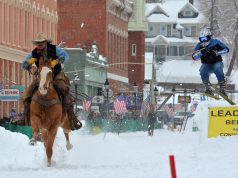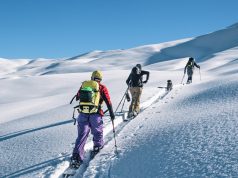The sky is the kind of perfect blue that you only find in Colorado, no clouds, no wind, no nothing. Only the faint trickle of water from a frozen creek as the sun spills its warmth down on the planet. Then the cat rumbles to life as we climb aboard, the snow scrunching under our ski boots. The sound of the cat shatters the silence, shatters the early morning calm and adds to the healthy dose of adrenaline that is already pumping through our veins. While we’ve been up since 6 a.m., we don’t need any coffee. The cat is enough.
Jones Pass sits on the eastern side of Berthoud Pass.
While less than 1.5 hours from Boulder, the area feels remote, far from the hoards that ply Interstate 70 en route to lift-served skiing and the crowded party ski scene of resorts like Copper Mountain and Vail. But the sense of solitude is deceiving. Snowmobilers and backcountry skiers ply their trades here on weekends, when Jones Pass becomes a home away from home for those in on the secret. The Henderson molybdenum mine is also located here. With one of the largest molybdenum ore deposits in North America, the mine has produced more than 770 million pounds of ore since starting operations in 1976. Then there’s Powder Addiction cat skiing, the fledging guide company and the newest addition to the Jones Pass landscape. Powder Addiction has been feeding skiers and snowboarders a diet of fresh snow and great riding since starting operations in last winter and is quickly becoming an not-so secret secret as word-of-mouth advertising spreads the message about the epic terrain and great snow that the operation accesses.
We hit Powder Addiction on a quiet weekday, sharing the parking lot with fellow cat skiers, a couple of Nordic skiers and a guy with a snowmobile. The operation is headed up by Jamie Wolter, a ripping Telemark skier with a big smile who seems pretty satisfied with the line of work he’s found himself in. No stranger to Jones Pass, Wolter used to oversee avalanche control work and snow safety at the now defunct Berthoud Pass ski area nearby and is currently employed in a comparable position at Winter Park ski area. The years of knowledge he brings to the table at Jones Pass are comforting, as the cat operation doesn’t use explosives to run avalanche control on the terrain they take clients to.
We got a taste of this terrain on our first run, when the cat topped out as the highest zone the operation services. The area, perched against the Continental Divide, was open and steep, perfect for skiing and also perfect for avalanches. But with Wolter giving us the OK, it wasn’t long before we dropped in, creamy windbuff on the ridge quickly giving way to silky turns in the gut of the chute.
It’s this terrain that sets Powder Addiction apart from the competition. Serving 2,600 acres, the operation features some of the most expansive cat skiing in the state. And there’s little doubt that not only are Powder Addiction’s runs some of the longest, but they’re
also some of the steepest, too.
“We
don’t really worry about spooning tracks or keeping people in a small
zone to preserve the snow for clients coming later in the week,” says
Wolter. “There’s so much up here that we never track it all out. We have
maximum of 12 clients per day, so there’s always plenty of snow to go
around. Even the guides still haven’t skied some of the runs we can
access.”
Wolter’s
causal approach to “snow conservation” was underlined on our next lap,
where we attacked a craggy ridge with several small rocky chutes. The
jagged chutes held six inches of untouched powder in their embrace. It
was so good that when we suggested to Wolter that perhaps we should
sample the zone again, he quickly agreed. Not only did we go back up,
but we kept doing so until every line was fully skied out, and our grins
were nearly as big as Wolter’s.
Not all of the terrain here is for experts, though.
With a variety of open bowls, gladed tree runs and open meadows, the
operation is ideal for neophytes who haven’t had the opportunity to test
themselves in Colorado’s backcountry, are trying to get their powder
legs under them or who are just becoming familiar with steeper terrain.
“We have something for
everyone,” says Wolter, gesturing to an expanse of wide open white
spaces. “And if people get bored of this, we can hike out those ridges
for even more terrain.”
While we did end up hiking a bit, most groups will merely jump
out of the cat, jump into their skis or snowboard and point ’em down.
And that’s just what
we did on our next run, with the cat taking us to a point high on a
ridge, where we could easily see the results of years of mining over at
Henderson. While environmentalists will cringe at the site of the mine’s
“glory hole,” the massive crater where ore has been mined is a living
testament to Jones Pass’ extensive mining history. Before skiers and
snowmobilers invaded this area, Jones Pass was home to gold and silver
mining. In fact, the current molybdenum operation is merely the
continuation of decades of mining here.
That history is on display at nearby Empire.
The town was founded in the late 1800s during Colorado’s silver and gold
boom and is home to several historic structures, including the Peck
House, one of the oldest hotels in the state. The establishment has
hosted many luminaries, including P.T. Barnum, General Sherman and
Ulysses S. Grant. It’s still possible to book a room here and enjoy an
ambiance that captures the opulence and optimism of the late 1800s.
Empire’s Peck House is joined by the original Hard Rock Cafe. Built in
1932, the cafe — which has no relation to the modern establishment of
the same name — catered to the hard rock miners who worked in the area.
Empire and the Jones
Pass area are still home to numerous mining claims, although you won’t
see any silver or gold mining on your cat excursion, despite the current
investment craze for gold. Most of the ore was played out years ago,
and things have also gotten quieter over at the Henderson Mine in the
wake of lower commodity prices and slagging demand for molybdenum.
Despite the area’s rich
history, no one really knows who Mr. Jones was or why the pass was named
after him. Even Wolter is stumped.
“I don’t really know why it’s called Jones Pass,” he
admits between runs. “I’m not sure.”
But if ignorance is bliss, then the last lap, off a
high shoulder right at treeline, proved that you don’t have to be a
student of mining, snow or even history to appreciate the modern riches
that the area offers. The line was a massive avalanche chute that
tumbled into powdery oblivion. We stopped at the top to take it all in:
the huge crater of the Henderson mine, the innumerable peaks on the
horizon, the Continental Divide and the sunburned smiles on the faces of
our friends and the guides. It had been a good day, no, a great day.
And, with one more untouched shot plunging below us, it wasn’t over yet.
Respond: [email protected]
For more information:
Powder Addiction’s spring cat skiing special costs $200/per person, per day or $2,000 for a private cat. Skiers will average 6 to 9 runs a day at elevations ranging from 10,500 to 12,500 feet. Tours include lunch and aprés ski beers. Call 970-726-5442, or go to powderaddiction.com














